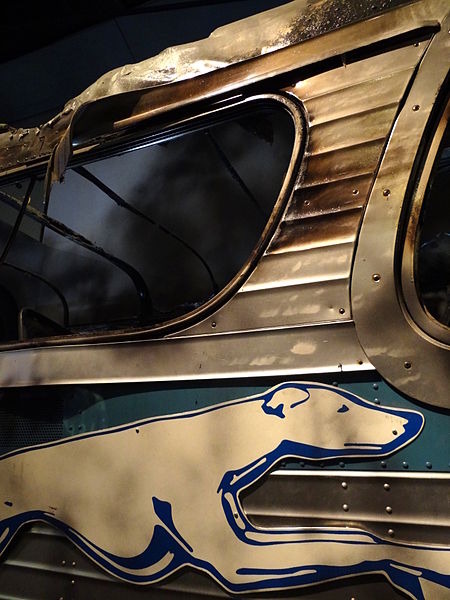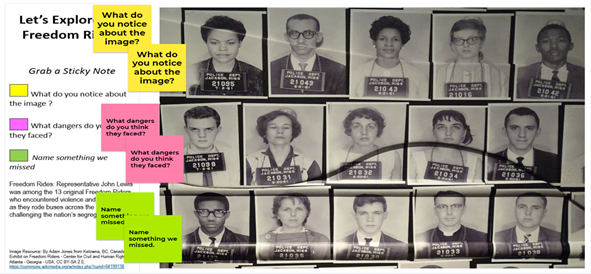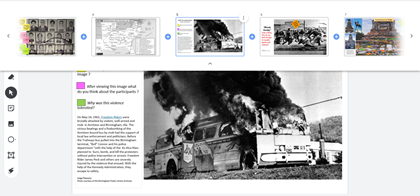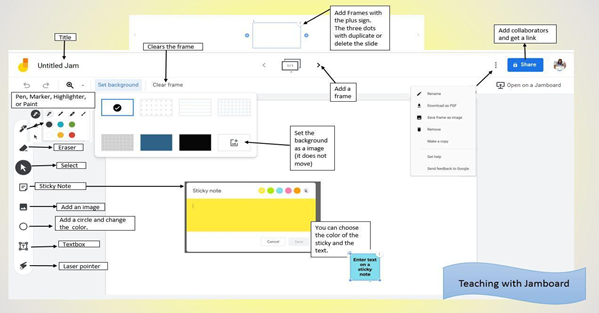- Author:
- Woodson Collaborative, Lillian Allen-Brown
- Subject:
- History/Social Sciences, American History, Virginia History
- Material Type:
- Lesson
- Level:
- Middle School, High School
- Tags:
- License:
- Creative Commons Attribution Non-Commercial
- Language:
- English
- Media Formats:
- Downloadable docs, Text/HTML
Education Standards
Freedom Riders LE
Freedom Riders STUDENT PAGE
Freedom Rides

Overview
The students will analyze the 6 primary resource image frames. The Jamboard activity focuses on the Civil Rights Movement’s Freedom Riders. In 1961, this group of volunteer participants rode interstate buses throughout the segregated southern United States. Their goal was to challenge the United States Supreme Court ruling “Separate but Equal” which was used to mandate separate black and white waiting rooms at the interstate bus stations. The last frame connects the fight for Civil Rights to the massive Black Lives Matter movement in Richmond, Virginia.
INSTRUCTOR PAGE
A Jamboard
United States History II: 7th or Secondary History
Author: Lillian Brown: Portsmouth Public Schools
Task Overview: The students will analyze the 6 primary resource image frames. The Jamboard activity focuses on the Civil Rights Movement’s Freedom Riders. In 1961, this group of volunteer participants rode interstate buses throughout the segregated southern United States. Their goal was to challenge the United States Supreme Court ruling “Separate but Equal” which was used to mandate separate black and white waiting rooms at the interstate bus stations. The last frame connects the fight for Civil Rights to the massive Black Lives Matter movement in Richmond, Virginia. The images are the SOL I primary resource learning components, it is an observation teacher formative assessment, and the Jamboard format allows student participation. The Jamboard format slides can be printed in PDF.
Targeted SOLs: US II
USII.1 The student will demonstrate skills for historical thinking, geographical analysis, economic decision making, and responsible citizenship by
c) interpreting charts, graphs, and pictures to determine characteristics of people, places, or events in United States history;
USII.4 The student will apply social science skills to understand how life changed after the Civil War by
c) describing racial segregation, the rise of “Jim Crow,” and other constraints faced by African Americans and other groups in the post-Reconstruction South;
USII.9 The student will apply social science skills to understand the key domestic and international issues during the second half of the twentieth and early twenty-first centuries by
a) examining the impact of the Civil Rights Movement, the Americans with Disabilities Act (ADA), and the changing role of women on all Americans;
Unpacked Standards:
Know (facts) | Understand (concepts) | Do (skills) |
VDOE USII.4c Racial Segregation Also known as “Jim Crow” laws, named after a black character in minstrel shows, passed to discriminate against African Americans by forcing them into separate public accommodations. Made discrimination practices legal in many communities and states. Upheld by the Supreme Court in Plessy v. Ferguson in 1896.
VDOE US II.9a Some effects of segregation Separate and unequal educational facilities and resources Separate and unequal public facilities (e.g., restrooms, drinking fountains, restaurants) Segregated and disadvantaged neighborhoods Exclusion from well-paying jobs Undermining of wealth building by low property values in segregated neighborhoods Unpunished violence against African Americans
Some effects of segregation ●Separate and unequal educational facilities and resources ●Separate and unequal public facilities (e.g., restrooms, drinking fountains, restaurants) ●Unpunished violence against African Americans
Civil Rights Movement ●Opposition to Plessy v. Ferguson: “Separate but equal” ●Organized protests, Freedom Riders, sit-ins, marches, boycotts ●Bombing of churches and homes by white opponents of the Civil Rights movement | VDOE USII.4c Discrimination against African Americans and minority groups continued after Reconstruction. “Jim Crow” laws institutionalized a system of legal segregation. African Americans differed in their responses to discrimination and “Jim Crow.”
VDOE USII.9a The Civil Rights Movement of the twentieth century was committed to equal rights and fair treatment of African Americans, but it resulted in social, legal, political, and cultural changes that prohibited discrimination and segregation for all Americans. Other activists were inspired by the achievements of the Civil Rights Movement and took action to gain equality.
| Sample Analysis Tool Title of Informational Source: Key Elements Evidence Observation: What do you see? Source: Who created the source? Context: Where is the source located in terms of time and place? Historical Perspective: Whose point of view does the source represent? Analysis: What is the source’s impact on history?
VDOE SOL US II. 1c Interpreting involves using information found in charts, graphs, and pictures to develop an understanding of people, places, or events and draw conclusions. Close examination and interpretation of various data and images are essential to making informed decisions.
Experiences may include but are not limited to the following: Use historical maps to analyze changes in population over time. Gather information to explain resettlement of the American Indian population. Use primary-source images to show how new inventions changed life in America. Interpret photographs of the Civil Rights Movement. Discuss the photographer’s potential bias. Discuss the potential bias of the audience. Discuss the potential bias the photographs might cause.
|
Instructor Directions:
The students will analyze the photos and place sticky note responses to the images. The instructor needs to make a copy, then share it with the students as editors. The images are designed to tell a story and connect to today. The teacher will be able to assess student interaction immediately, electronic white board. This activity can be used in a group or individually. Alternatively, you may use the attached PDF file.
Jamboard Link: https://jamboard.google.com/d/14Aa6uo4fl1wyHul-_R6A_omUK4Z9_G2p1jjsDKAFimo/copy
Related Lessons: Civil Rights Sorting Cards
STUDENT PAGE
Directions:
The students will analyze the photos and place sticky note responses to the images.
In order to respond to the frames, students will use the Sticky function on the Jamboard: Several frames have color coded prompts. |


By the Dr. Carter G. Woodson Collaborative, 2021
Cover Image Credit: Wikimedia Commons


